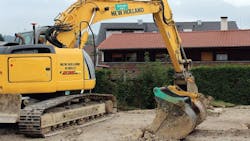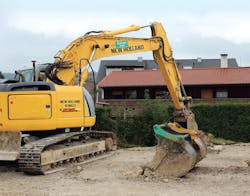Fluid Does Double Duty in Construction Equipment
This file type includes high-resolution graphics and schematics when applicable.
Construction companies always want to get projects done on time and under budget, and a high-efficiency hydraulic fluid lets them do both.
One thing Schrode GmbH, Hayingen, Germany, and Nuovo Ghizzoni SpA, Vidalenzo di Polesine, Italy, have in common is looking for ways to reduce operating costs and increase productivity. They were able to achieve both by retrofitting their hydraulic equipment with hydraulic fluid incorporating Dynavis technology, from Evonik Industries, Essen, Germany.
Schrode GmbH delivers what it describes as “the most sophisticated and advanced level of services” in its construction segment. Founded in 1994, the company is active in civil engineering, road building, garden design and construction, landscaping, water engineering, and in building natural stone walls. Owner and CEO Rainer Schrode is also chairman of Maschinentechnik Schrode AG (MTS). MTS specializes in the development and production of innovative accessory attachments for excavators, such as compactors and screening buckets — all operated hydraulically and connected through an automatic hydraulic quick-acting coupling.
Schrode management was immediately intrigued by the fuel-saving potential offered by high-efficiency hydraulic fluids. They decided to test the effectiveness of hydraulic fluid with Dynavis technology in a standard and rock milling job. They replaced the conventional hydraulic fluid in their New Holland and Liebherr excavators with a commercial high-performance hydraulic fluid formulated to Dynavis technology standards. The results were so impressive, Schrode management decided to change out their entire fleet to Dynavis-formulated hydraulic fluid.
New Holland’s E235 SR-LC is a 24-ton hydraulic excavator driven by a 118-kW diesel engine. The excavator was used in several civil-engineering construction projects where a standard bucket was frequently exchanged for a rock mill, a soil compactor, or a screening bucket. In addition, continuous operation in combination with high oil-flow rates characterized the excavator’s test conditions.
A significant reduction in fuel consumption was observed over eight weeks of testing. Before testing commenced, the excavator required refueling about every day and a half. During testing, however, the time between refueling stops increased to two days. So the testing not only reduced fuel costs, it also increased productivity by reducing the frequency of refueling. Furthermore, Dieter Pukowski, equipment operator, said the Dynavis-formulated hydraulic fluid clearly improved the handling. ”With the new oil in the hydraulic system, fuel stops have been reduced significantly. I can work nonstop for two days straight. Plus, when simultaneously activating different functions, for example, pivoting and compacting, there’s no more power loss.“
Rainer Schrode, CEO of Schrode GmbH and chairman of MTS AG, noted, “For us, it is of the utmost importance to be constantly faster and more efficient than our competitors. This applies to the construction services we provide as well as to our accessory attachments business. [The Dynavis-formulated] hydraulic fluid saves 10 to 15% fuel in mixed mode and up to 25% with heavy-stone milling. Based on diesel fuel at €1.45/liter ($7.50/gallon), that adds up to more than €6,000 (about $8,200) per year per excavator through reduced fuel consumption. We are also testing Dynavis technology in our Liebherr R924C excavator. Here, we see an even greater potential for savings.”
Higher viscosity index and more
Dynavis technology is a chemical-additive package incorporated into any of several hydraulic oil base stocks by fluid suppliers to increase the fluid’s viscosity index. Viscosity is probably the single most important characteristic of hydraulic fluid, or just about any other lubricant. If a fluid’s viscosity is too high, it may not achieve full-film lubrication, which could result in rapid wear from metal-to-metal contact between moving parts. Hydraulic equipment operating in cold environments or during cold startup is prone to this condition because base oils tend to become thicker at lower temperatures.
On the other hand, if a fluid’s viscosity is too low, the thin fluid will be unable to keep moving parts separated under load. The result will be the same — rapid wear from
metal-to-metal contact. This often occurs when hydraulic systems operate in hot environments or when heavy loading heats up the fluid. Temperature, again, is the culprit because just as hydraulic base oil tends to become thicker at lower temperatures, it tends to become thinner at higher temperatures.
Fluid suppliers circumvent this problem to some extent by adding viscosity index improvers to base oil. The higher a fluid’s viscosity index (VI), the less the fluid’s viscosity is affected by temperature. So a fluid with a high VI will be less prone to thickening at low temperatures and thinning at high temperatures than a fluid with a low VI.
However, Dr. Thomas Schimmel, Ph.D., Business Segment Manager, Hydraulic Fluids, at Evonik Industries, Parsippany, N.J., explained, “Dynavis technology is more than just a viscosity index improver.” He says that Dynavis technology provides other properties besides fuel efficiency, like excellent demulsibility and air release. Dynavis-formulated fluids are compliant with all major OEM standards.
Similar results in Italy
For more than 60 years, Nuovo Ghizzoni SpA has focused on the construction of pipelines for oil, gas, and water. Its large projects require a sizable fleet of highly productive construction machinery, and this, in turn, generates significant fuel costs. A project especially representative of Ghizzoni’s experience and know-how in pipelaying excavation was the construction of the Poggio Rentico — Cremona connection, a 22-month project completed in December 2012. This large-scale project required the laying of a 48-in. pipeline over 114 km across Italy’s Padan plain.
Once the pipe was in place and buried, a fleet of New Holland crawler excavators was deployed to replace topsoil for restoring the landscape. Giovanni Maffia, construction engineer at Ghizzoni, is always on the lookout for new fuel conservation options, and after learning about Dynavis-formulated hydraulic fluid, he wondered how much fuel could be saved by using it in Ghizzoni’s fleet of construction machinery.
Maffia, Ghizzoni’s project manager, Ghizzoni’s operators, and a team from Dynavis met to collaborate on the overall project, the site, and the equipment. A test program was mapped out, and New Holland E385B excavators had their hydraulic fluid reservoirs flushed and refilled with a Dynavis formulated hydraulic fluid.
With a fleet of 14 almost-identical excavators assigned to the singular task of restoring the topography of the pipeline route, the test lent itself to extrapolating test results from a limited sample of the excavators. In this way, the results obtained from a single excavator could be transferred to the fleet.
Precise recordkeeping
Maffia said that professional operators in large fleets of construction equipment, like those at Ghizzoni, excel at gathering detailed operating and fuel consumption data accurate down to the hour. For example: Ghizzoni’s New Holland crawler excavator 385B with the asset number AZ663.2 showed 4,849 operating hours on its counter before the test start. Once it reached operating hour 4,952, the first test evaluation was made. Fuel consumption of the 125 hr preceding the test was used as a comparable quantity.
The test evaluation determined that the excavator had achieved an average reduction of fuel consumption of 9.89%. The excavator had saved €35 (about $48) per day in fuel. More importantly, the results from this single excavator suggested that a monthly savings potential of €10,000 (about $13,660) could be achieved for the entire fleet. Tests for a second excavator inherited a different history. For example, the excavator had been used in a different type of application. Still, fuel savings turned out to be 18%.
Even though official documentation showed a 9.89% reduction in fuel consumption, the collaborative team realized that this figure may not represent the maximum savings potential for all cases. According to Maffia, “Since the very beginning, the machine operators experienced a better handling of the machine. Also really important for us is an improvement of around 10% in terms of fuel consumption.”
FOR MORE information, call Evonik Industries, Parsippany, N.J., at (973) 929-8000 or visit north-america.evonik.com.
HYDRAULIC FLUIDS and other lubricants incorporating Dynavis technology are distributed in North America by Total Lubricants USA Inc., Linden, N.J. For information, call (800) 323-3198, or visit www.total-us.com. For a full list of companies offering hydraulic fluid incorporating Dynavis technology, visit bit.ly/HP147Dynavis.



